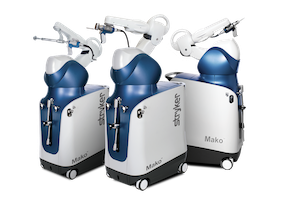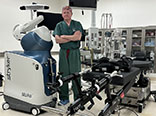Meet the MAKO.
The Surgery Center of Fairbanks
First to Provide Robotic Joint Replacement in Northern Alaska
The Surgery Center of Fairbanks, Dr. Mark Wade and Dr. Neil Everson are the first providers in Northern Alaska to use advanced robotics technology for partial and total joint replacements, bringing substantial new benefits to patients suffering from joint disorders.
The Stryker MAKO Robotic Arm is being used to provide hip, knee, ankle and shoulder joint replacements, relieving pain caused by joint degeneration. MAKO-assisted surgeries are already underway at The Surgery Center by Drs. Wade and Everson.
Robotic-assisted surgeries are a significant advancement in joint replacement. The technology brings a significantly higher level of precision and patient-specific implant positioning than manual procedures. It allows surgeons to create patient-specific plans and perform partial and total joint replacements with a surgeon-controlled robotic-arm for greater accuracy.
“The MAKO is transforming the way joint replacement surgeries are performed,” said Dr. Wade. It gives us the ability to create and carry out a personalized surgery plan based on the patient’s unique anatomy.
“Before surgery, we take a CT scan of the joint which is used to develop a 3D virtual model of the patient’s joint. This allows us to evaluate bone structure, disease severity and joint alignment, as well as the surrounding bone and tissue to optimize protection for the structure surrounding the joint. Using the virtual model, we have the ability to personalize a patient’s surgery in advance and have a clear plan for how to position the joint implant before entering the operating room.
During surgery, we re-validate the plan and make any necessary adjustments. The robotic arm then allows us to carry out the plan with a high level of accuracy. The advantages to the patient are substantial. Studies show that MAKO assisted joint surgeries are up to 4 times more accurate1 and lead to better outcomes and greater satisfaction than manual procedures, including less pain and shorter recovery times compared to traditional joint replacement surgery. It helps patients to get back to doing the things they love more quickly.”
Dr. Everson said, “The MAKO has distinct advantages. While the surgeon still performs the procedure, the robot is not subject to fatigue, for example. It can make more precise movements and surgeons are guided by a high-resolution magnifying camera that provide 3D imaging and can make real-time computer-assisted calculations. Prosthetic devices can be placed more accurately with superior long-term surgical outcomes. The MAKO does not replace the surgeon’s expertise, rather it enables greater customization and accuracy for the specifics of each patient’s joint.”
”We are proud to be the first to use this innovative technology in Northern Alaska,” added Dr. Wade “It is an integral part of our commitment to provide residents of Fairbanks and all of Northern Alaska with the most advanced surgical options. In the past, patients have been required to travel to receive robotic surgery. Now they can stay at home for both the surgery and recovery which reinforces the improvement in surgical outcomes, provides greater convenience and lowers costs.”

- Nawabi, DH, Conditt,MA, Ranawat AS, Dunbar NJ et al. Haptically guided robotic technology in total hip arthroplasty: a cadaveric investigation. Journal of Engineering in Medicine. December 2012:227(3):302-309.
- Dunbar NJ, Roche MW, Park BH, Branch SH; et al. Accuracy of Dynamic Tactile-Guided Unicompartmental Knee Arthroplasty. Journal of Arthroplasty. May 2012. 27(5): 803-808.e1.
- Lonner, JH. Robotic-Arm Assisted Unicompartmental Knee Arthroplasty. Seminars in Arthroplasty. 2009. 20(1): 15-22.
- Lonner JH, John TK, Conditt MA. Robotic Arm-Assisted UKA Improved Tibial Component Alignment: A Pilot Study Clin Orthop Relat Res. July 2010. 468(1):141-6.





